ECO202 Macroeconomics Assignment: Unemployment & Fiscal Impact
VerifiedAdded on 2023/06/11
|11
|1270
|275
Homework Assignment
AI Summary
This assignment solution covers key macroeconomic concepts, including Okun's Law, planned aggregate expenditure, and the impact of fiscal policy. It analyzes the relationship between unemployment and output gaps, calculates equilibrium output, and determines the real interest rate needed for full employment. Furthermore, it examines the effects of international trade and tariffs on domestic markets, and explores the components of national saving. The document provides detailed calculations and explanations for each question, offering a comprehensive understanding of the principles involved. Find more solved assignments and study resources on Desklib.
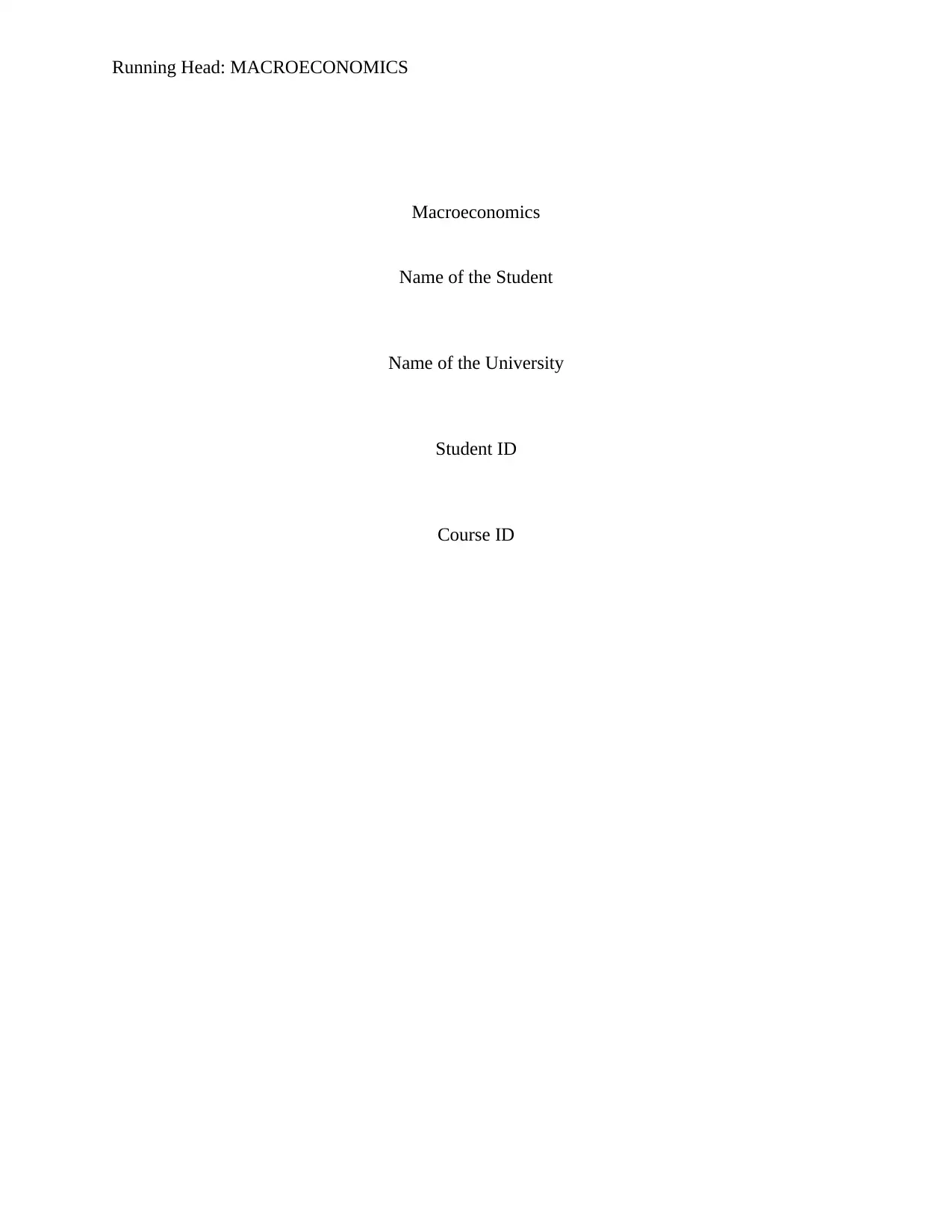
Running Head: MACROECONOMICS
Macroeconomics
Name of the Student
Name of the University
Student ID
Course ID
Macroeconomics
Name of the Student
Name of the University
Student ID
Course ID
Paraphrase This Document
Need a fresh take? Get an instant paraphrase of this document with our AI Paraphraser
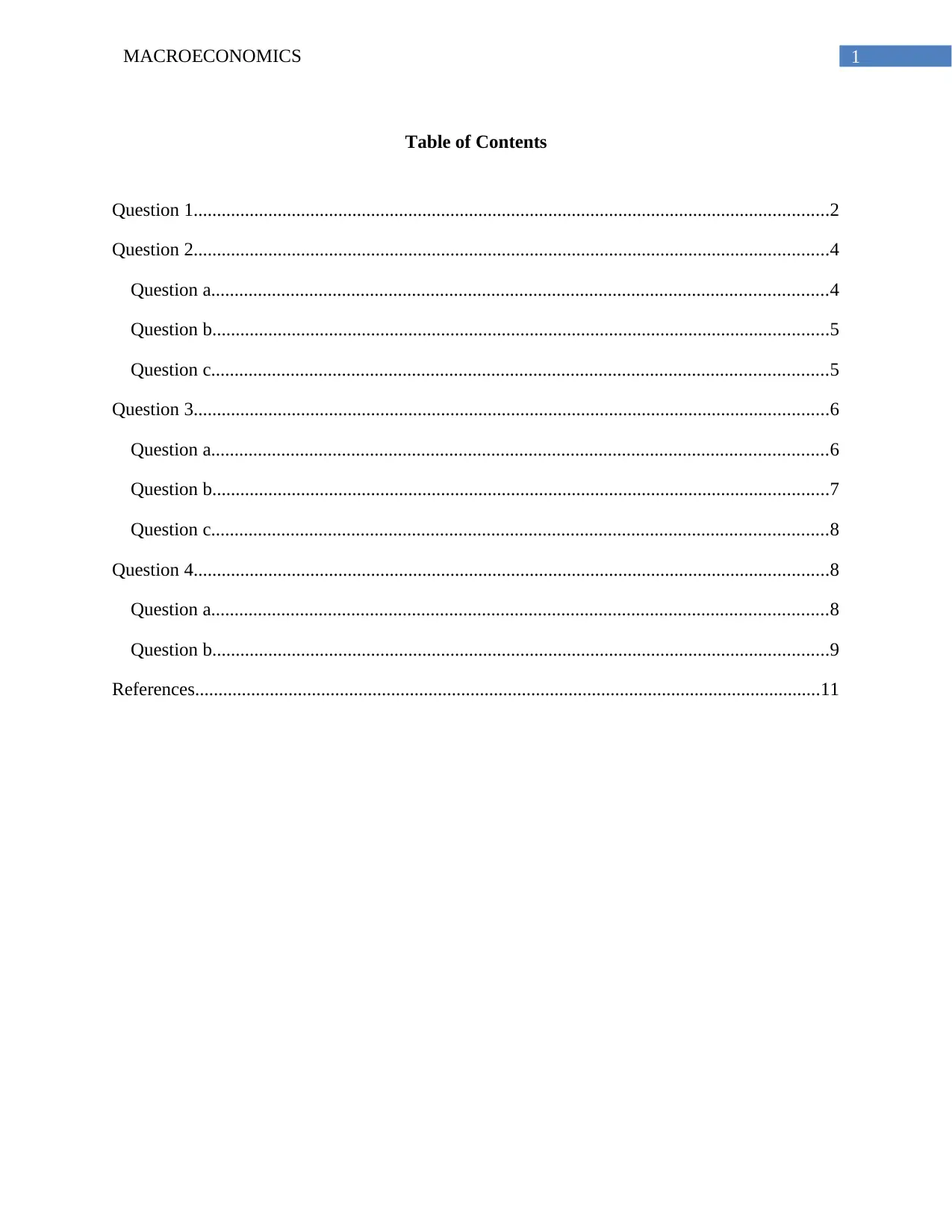
1MACROECONOMICS
Table of Contents
Question 1........................................................................................................................................2
Question 2........................................................................................................................................4
Question a....................................................................................................................................4
Question b....................................................................................................................................5
Question c....................................................................................................................................5
Question 3........................................................................................................................................6
Question a....................................................................................................................................6
Question b....................................................................................................................................7
Question c....................................................................................................................................8
Question 4........................................................................................................................................8
Question a....................................................................................................................................8
Question b....................................................................................................................................9
References......................................................................................................................................11
Table of Contents
Question 1........................................................................................................................................2
Question 2........................................................................................................................................4
Question a....................................................................................................................................4
Question b....................................................................................................................................5
Question c....................................................................................................................................5
Question 3........................................................................................................................................6
Question a....................................................................................................................................6
Question b....................................................................................................................................7
Question c....................................................................................................................................8
Question 4........................................................................................................................................8
Question a....................................................................................................................................8
Question b....................................................................................................................................9
References......................................................................................................................................11
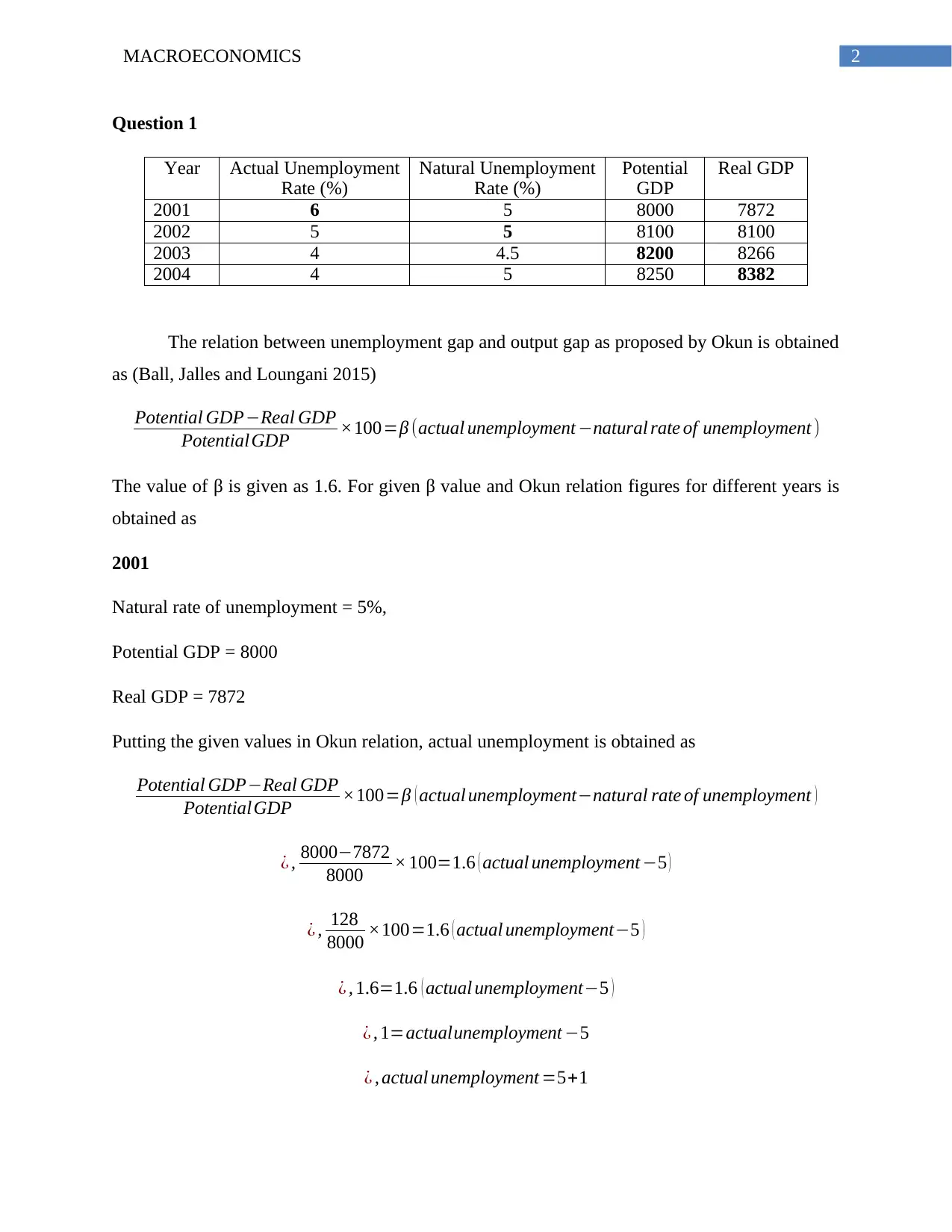
2MACROECONOMICS
Question 1
Year Actual Unemployment
Rate (%)
Natural Unemployment
Rate (%)
Potential
GDP
Real GDP
2001 6 5 8000 7872
2002 5 5 8100 8100
2003 4 4.5 8200 8266
2004 4 5 8250 8382
The relation between unemployment gap and output gap as proposed by Okun is obtained
as (Ball, Jalles and Loungani 2015)
Potential GDP−Real GDP
PotentialGDP ×100=β (actual unemployment −natural rate of unemployment )
The value of β is given as 1.6. For given β value and Okun relation figures for different years is
obtained as
2001
Natural rate of unemployment = 5%,
Potential GDP = 8000
Real GDP = 7872
Putting the given values in Okun relation, actual unemployment is obtained as
Potential GDP−Real GDP
PotentialGDP ×100=β ( actual unemployment−natural rate of unemployment )
¿ , 8000−7872
8000 × 100=1.6 ( actual unemployment −5 )
¿ , 128
8000 ×100=1.6 ( actual unemployment−5 )
¿ , 1.6=1.6 ( actual unemployment−5 )
¿ , 1=actualunemployment −5
¿ , actual unemployment =5+1
Question 1
Year Actual Unemployment
Rate (%)
Natural Unemployment
Rate (%)
Potential
GDP
Real GDP
2001 6 5 8000 7872
2002 5 5 8100 8100
2003 4 4.5 8200 8266
2004 4 5 8250 8382
The relation between unemployment gap and output gap as proposed by Okun is obtained
as (Ball, Jalles and Loungani 2015)
Potential GDP−Real GDP
PotentialGDP ×100=β (actual unemployment −natural rate of unemployment )
The value of β is given as 1.6. For given β value and Okun relation figures for different years is
obtained as
2001
Natural rate of unemployment = 5%,
Potential GDP = 8000
Real GDP = 7872
Putting the given values in Okun relation, actual unemployment is obtained as
Potential GDP−Real GDP
PotentialGDP ×100=β ( actual unemployment−natural rate of unemployment )
¿ , 8000−7872
8000 × 100=1.6 ( actual unemployment −5 )
¿ , 128
8000 ×100=1.6 ( actual unemployment−5 )
¿ , 1.6=1.6 ( actual unemployment−5 )
¿ , 1=actualunemployment −5
¿ , actual unemployment =5+1
⊘ This is a preview!⊘
Do you want full access?
Subscribe today to unlock all pages.

Trusted by 1+ million students worldwide
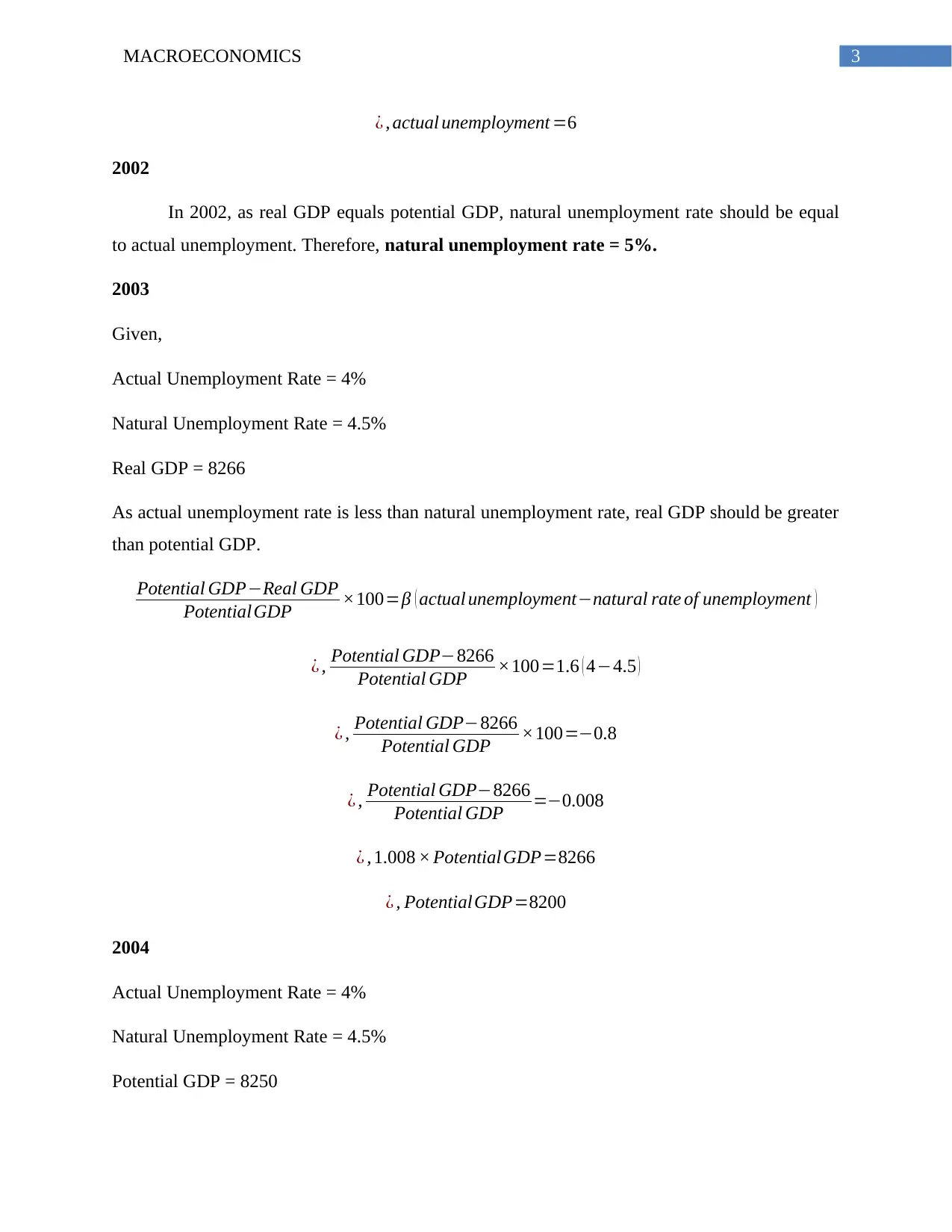
3MACROECONOMICS
¿ , actual unemployment =6
2002
In 2002, as real GDP equals potential GDP, natural unemployment rate should be equal
to actual unemployment. Therefore, natural unemployment rate = 5%.
2003
Given,
Actual Unemployment Rate = 4%
Natural Unemployment Rate = 4.5%
Real GDP = 8266
As actual unemployment rate is less than natural unemployment rate, real GDP should be greater
than potential GDP.
Potential GDP−Real GDP
PotentialGDP ×100=β ( actual unemployment−natural rate of unemployment )
¿ , Potential GDP−8266
Potential GDP ×100=1.6 ( 4−4.5 )
¿ , Potential GDP−8266
Potential GDP ×100=−0.8
¿ , Potential GDP−8266
Potential GDP =−0.008
¿ , 1.008 × PotentialGDP=8266
¿ , PotentialGDP=8200
2004
Actual Unemployment Rate = 4%
Natural Unemployment Rate = 4.5%
Potential GDP = 8250
¿ , actual unemployment =6
2002
In 2002, as real GDP equals potential GDP, natural unemployment rate should be equal
to actual unemployment. Therefore, natural unemployment rate = 5%.
2003
Given,
Actual Unemployment Rate = 4%
Natural Unemployment Rate = 4.5%
Real GDP = 8266
As actual unemployment rate is less than natural unemployment rate, real GDP should be greater
than potential GDP.
Potential GDP−Real GDP
PotentialGDP ×100=β ( actual unemployment−natural rate of unemployment )
¿ , Potential GDP−8266
Potential GDP ×100=1.6 ( 4−4.5 )
¿ , Potential GDP−8266
Potential GDP ×100=−0.8
¿ , Potential GDP−8266
Potential GDP =−0.008
¿ , 1.008 × PotentialGDP=8266
¿ , PotentialGDP=8200
2004
Actual Unemployment Rate = 4%
Natural Unemployment Rate = 4.5%
Potential GDP = 8250
Paraphrase This Document
Need a fresh take? Get an instant paraphrase of this document with our AI Paraphraser
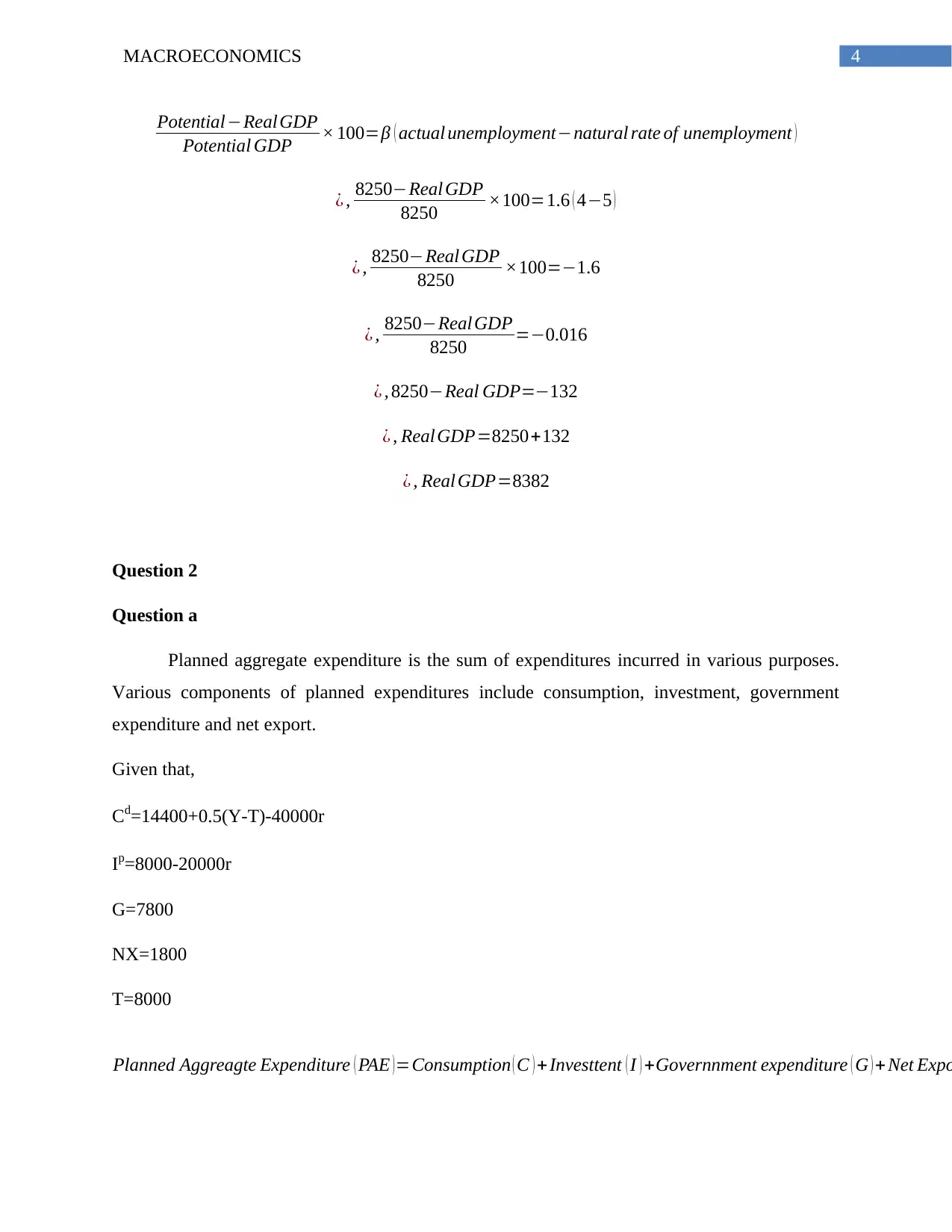
4MACROECONOMICS
Potential−Real GDP
Potential GDP × 100=β ( actual unemployment−natural rate of unemployment )
¿ , 8250−Real GDP
8250 ×100=1.6 ( 4−5 )
¿ , 8250−Real GDP
8250 ×100=−1.6
¿ , 8250−Real GDP
8250 =−0.016
¿ , 8250−Real GDP=−132
¿ , Real GDP=8250+132
¿ , Real GDP=8382
Question 2
Question a
Planned aggregate expenditure is the sum of expenditures incurred in various purposes.
Various components of planned expenditures include consumption, investment, government
expenditure and net export.
Given that,
Cd=14400+0.5(Y-T)-40000r
Ip=8000-20000r
G=7800
NX=1800
T=8000
Planned Aggreagte Expenditure ( PAE )=Consumption ( C ) + Investtent ( I ) +Governnment expenditure ( G ) + Net Expo
Potential−Real GDP
Potential GDP × 100=β ( actual unemployment−natural rate of unemployment )
¿ , 8250−Real GDP
8250 ×100=1.6 ( 4−5 )
¿ , 8250−Real GDP
8250 ×100=−1.6
¿ , 8250−Real GDP
8250 =−0.016
¿ , 8250−Real GDP=−132
¿ , Real GDP=8250+132
¿ , Real GDP=8382
Question 2
Question a
Planned aggregate expenditure is the sum of expenditures incurred in various purposes.
Various components of planned expenditures include consumption, investment, government
expenditure and net export.
Given that,
Cd=14400+0.5(Y-T)-40000r
Ip=8000-20000r
G=7800
NX=1800
T=8000
Planned Aggreagte Expenditure ( PAE )=Consumption ( C ) + Investtent ( I ) +Governnment expenditure ( G ) + Net Expo
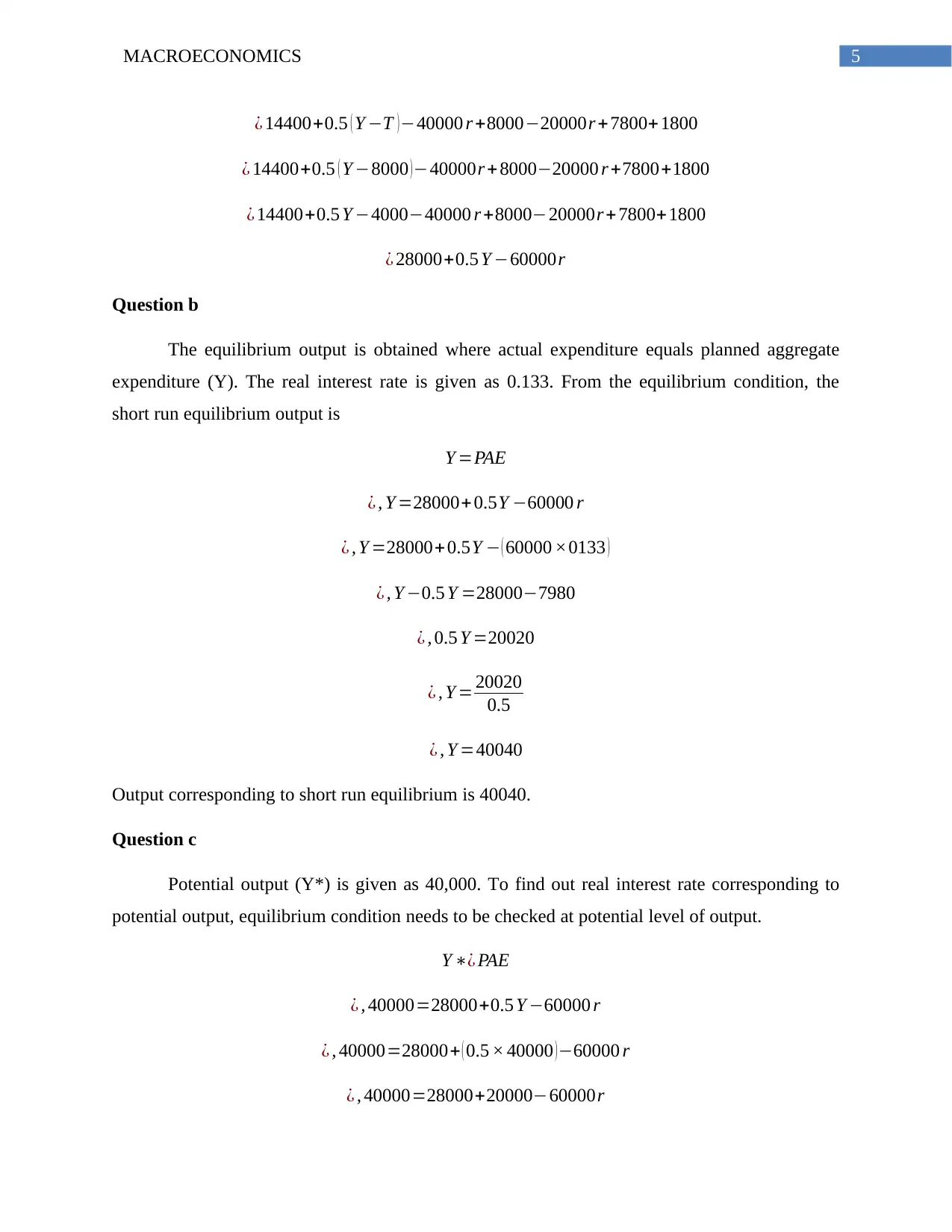
5MACROECONOMICS
¿ 14400+0.5 ( Y −T ) −40000 r +8000−20000r +7800+ 1800
¿ 14400+0.5 ( Y −8000 )−40000r + 8000−20000 r +7800+1800
¿ 14400+0.5 Y −4000−40000 r +8000−20000r +7800+1800
¿ 28000+0.5 Y −60000r
Question b
The equilibrium output is obtained where actual expenditure equals planned aggregate
expenditure (Y). The real interest rate is given as 0.133. From the equilibrium condition, the
short run equilibrium output is
Y =PAE
¿ , Y =28000+ 0.5Y −60000 r
¿ , Y =28000+0.5Y − ( 60000 ×0133 )
¿ , Y −0.5 Y =28000−7980
¿ , 0.5 Y =20020
¿ , Y = 20020
0.5
¿ , Y =40040
Output corresponding to short run equilibrium is 40040.
Question c
Potential output (Y*) is given as 40,000. To find out real interest rate corresponding to
potential output, equilibrium condition needs to be checked at potential level of output.
Y ∗¿ PAE
¿ , 40000=28000+0.5 Y −60000 r
¿ , 40000=28000+ ( 0.5 × 40000 )−60000 r
¿ , 40000=28000+20000−60000r
¿ 14400+0.5 ( Y −T ) −40000 r +8000−20000r +7800+ 1800
¿ 14400+0.5 ( Y −8000 )−40000r + 8000−20000 r +7800+1800
¿ 14400+0.5 Y −4000−40000 r +8000−20000r +7800+1800
¿ 28000+0.5 Y −60000r
Question b
The equilibrium output is obtained where actual expenditure equals planned aggregate
expenditure (Y). The real interest rate is given as 0.133. From the equilibrium condition, the
short run equilibrium output is
Y =PAE
¿ , Y =28000+ 0.5Y −60000 r
¿ , Y =28000+0.5Y − ( 60000 ×0133 )
¿ , Y −0.5 Y =28000−7980
¿ , 0.5 Y =20020
¿ , Y = 20020
0.5
¿ , Y =40040
Output corresponding to short run equilibrium is 40040.
Question c
Potential output (Y*) is given as 40,000. To find out real interest rate corresponding to
potential output, equilibrium condition needs to be checked at potential level of output.
Y ∗¿ PAE
¿ , 40000=28000+0.5 Y −60000 r
¿ , 40000=28000+ ( 0.5 × 40000 )−60000 r
¿ , 40000=28000+20000−60000r
⊘ This is a preview!⊘
Do you want full access?
Subscribe today to unlock all pages.

Trusted by 1+ million students worldwide

6MACROECONOMICS
¿ , 60000 r=28000+20000−40000
¿ , 60000 r=8000∨, r= 8000
60000
¿ , r=0.1333
Reserve bank should set a real interest rate of 0.1333 in order to bring the economy to full
employment.
Question 3
Question a
Demand for car in the country is given as
D=12000−200 P
Supply of domestic car production is
S=7000+ 50 P
Equilibrium price and output is obtained where demand in the country matches with domestic car
production.
Demand=Supply
¿ , 12000−200 P=7000+ 50 P
¿ , 200 P+50 P=12000−7000
¿ , 250 P=5000
¿ , P= 5000
250
¿ , P=20
At equilibrium price of 20, production of car is obtained from the supply function
S=7000+ 50 P
¿ 7000+ ( 50 ×20 )
¿ , 60000 r=28000+20000−40000
¿ , 60000 r=8000∨, r= 8000
60000
¿ , r=0.1333
Reserve bank should set a real interest rate of 0.1333 in order to bring the economy to full
employment.
Question 3
Question a
Demand for car in the country is given as
D=12000−200 P
Supply of domestic car production is
S=7000+ 50 P
Equilibrium price and output is obtained where demand in the country matches with domestic car
production.
Demand=Supply
¿ , 12000−200 P=7000+ 50 P
¿ , 200 P+50 P=12000−7000
¿ , 250 P=5000
¿ , P= 5000
250
¿ , P=20
At equilibrium price of 20, production of car is obtained from the supply function
S=7000+ 50 P
¿ 7000+ ( 50 ×20 )
Paraphrase This Document
Need a fresh take? Get an instant paraphrase of this document with our AI Paraphraser
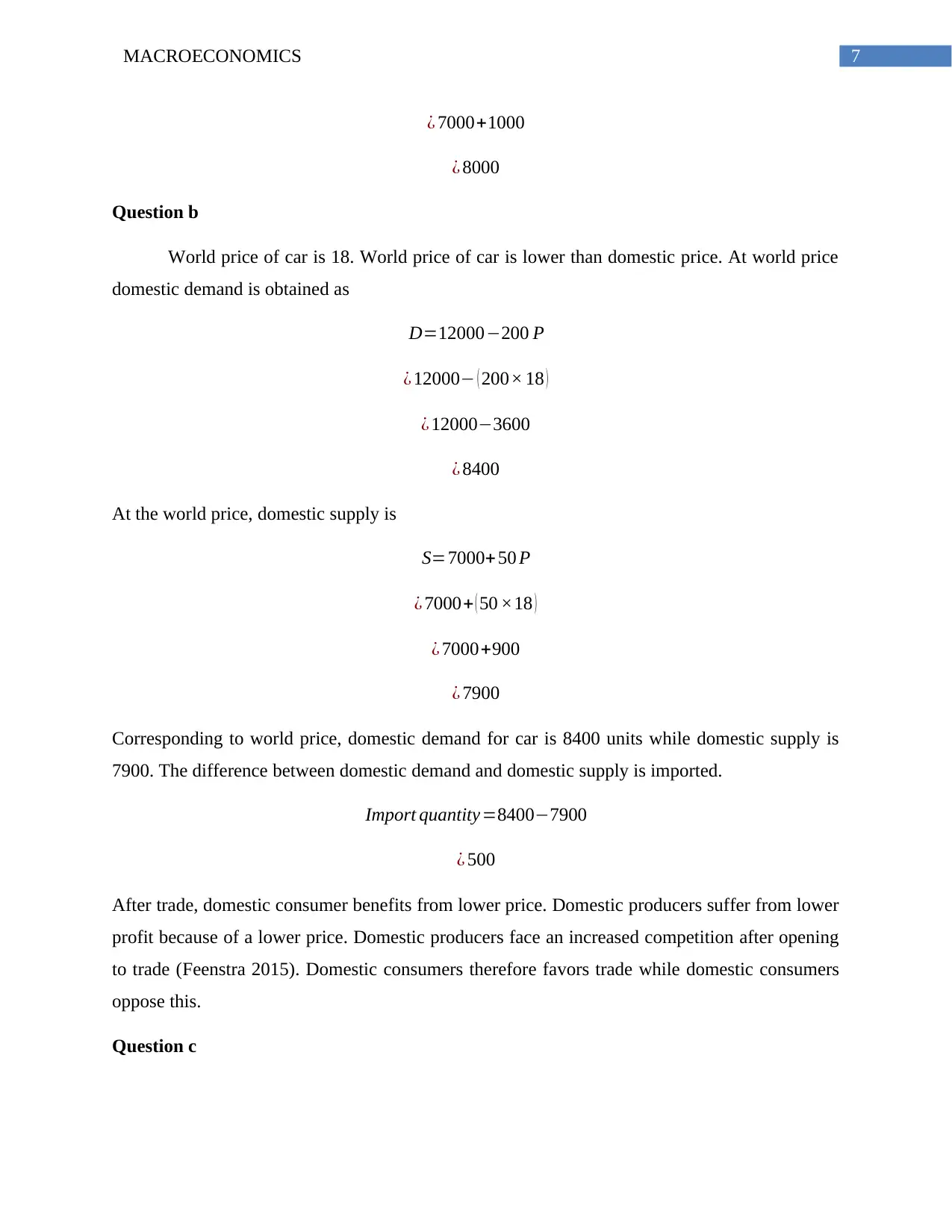
7MACROECONOMICS
¿ 7000+1000
¿ 8000
Question b
World price of car is 18. World price of car is lower than domestic price. At world price
domestic demand is obtained as
D=12000−200 P
¿ 12000− ( 200× 18 )
¿ 12000−3600
¿ 8400
At the world price, domestic supply is
S=7000+ 50 P
¿ 7000+ ( 50 ×18 )
¿ 7000+900
¿ 7900
Corresponding to world price, domestic demand for car is 8400 units while domestic supply is
7900. The difference between domestic demand and domestic supply is imported.
Import quantity =8400−7900
¿ 500
After trade, domestic consumer benefits from lower price. Domestic producers suffer from lower
profit because of a lower price. Domestic producers face an increased competition after opening
to trade (Feenstra 2015). Domestic consumers therefore favors trade while domestic consumers
oppose this.
Question c
¿ 7000+1000
¿ 8000
Question b
World price of car is 18. World price of car is lower than domestic price. At world price
domestic demand is obtained as
D=12000−200 P
¿ 12000− ( 200× 18 )
¿ 12000−3600
¿ 8400
At the world price, domestic supply is
S=7000+ 50 P
¿ 7000+ ( 50 ×18 )
¿ 7000+900
¿ 7900
Corresponding to world price, domestic demand for car is 8400 units while domestic supply is
7900. The difference between domestic demand and domestic supply is imported.
Import quantity =8400−7900
¿ 500
After trade, domestic consumer benefits from lower price. Domestic producers suffer from lower
profit because of a lower price. Domestic producers face an increased competition after opening
to trade (Feenstra 2015). Domestic consumers therefore favors trade while domestic consumers
oppose this.
Question c
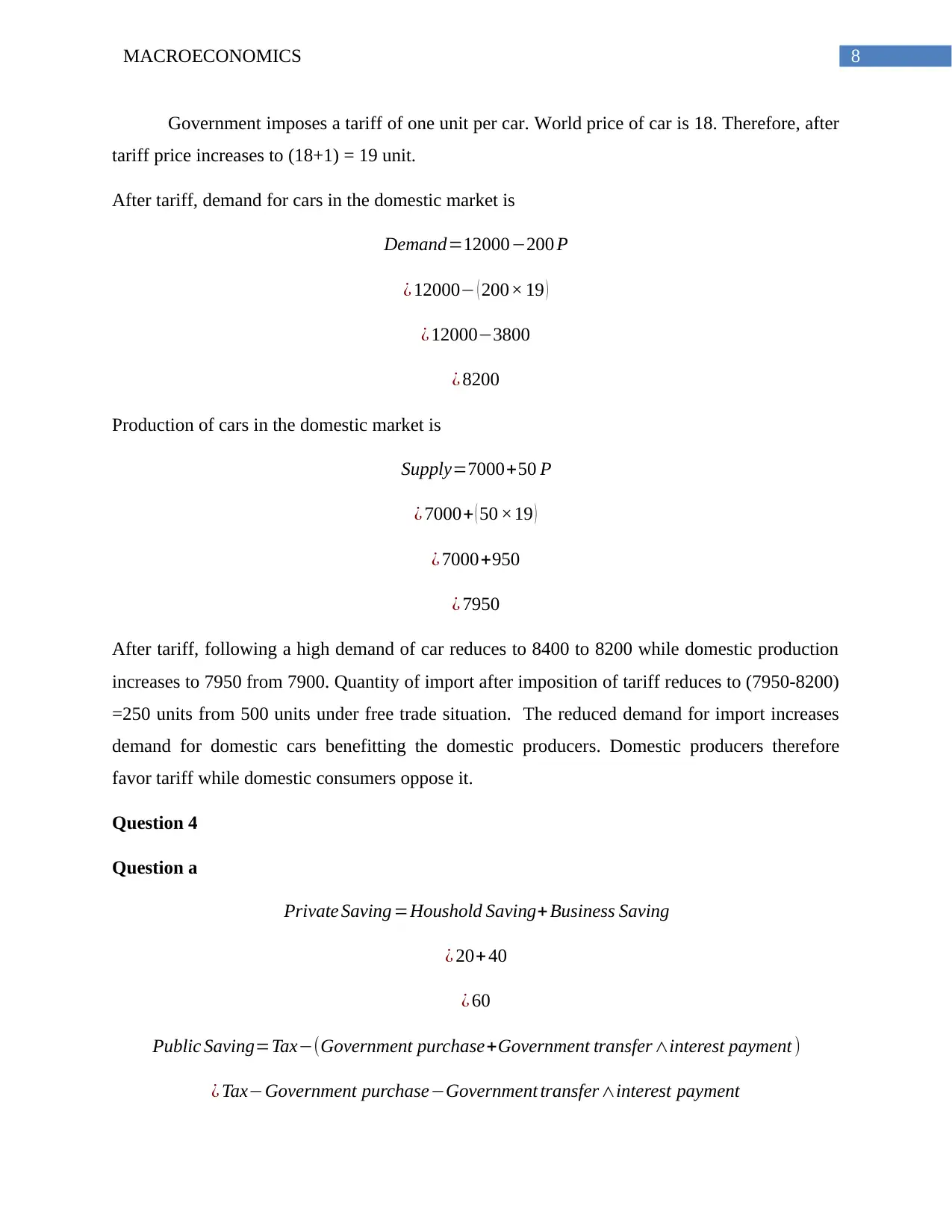
8MACROECONOMICS
Government imposes a tariff of one unit per car. World price of car is 18. Therefore, after
tariff price increases to (18+1) = 19 unit.
After tariff, demand for cars in the domestic market is
Demand=12000−200 P
¿ 12000− ( 200× 19 )
¿ 12000−3800
¿ 8200
Production of cars in the domestic market is
Supply=7000+50 P
¿ 7000+ ( 50 ×19 )
¿ 7000+950
¿ 7950
After tariff, following a high demand of car reduces to 8400 to 8200 while domestic production
increases to 7950 from 7900. Quantity of import after imposition of tariff reduces to (7950-8200)
=250 units from 500 units under free trade situation. The reduced demand for import increases
demand for domestic cars benefitting the domestic producers. Domestic producers therefore
favor tariff while domestic consumers oppose it.
Question 4
Question a
Private Saving =Houshold Saving+ Business Saving
¿ 20+ 40
¿ 60
Public Saving=Tax−(Government purchase+Government transfer∧interest payment )
¿ Tax−Government purchase−Government transfer∧interest payment
Government imposes a tariff of one unit per car. World price of car is 18. Therefore, after
tariff price increases to (18+1) = 19 unit.
After tariff, demand for cars in the domestic market is
Demand=12000−200 P
¿ 12000− ( 200× 19 )
¿ 12000−3800
¿ 8200
Production of cars in the domestic market is
Supply=7000+50 P
¿ 7000+ ( 50 ×19 )
¿ 7000+950
¿ 7950
After tariff, following a high demand of car reduces to 8400 to 8200 while domestic production
increases to 7950 from 7900. Quantity of import after imposition of tariff reduces to (7950-8200)
=250 units from 500 units under free trade situation. The reduced demand for import increases
demand for domestic cars benefitting the domestic producers. Domestic producers therefore
favor tariff while domestic consumers oppose it.
Question 4
Question a
Private Saving =Houshold Saving+ Business Saving
¿ 20+ 40
¿ 60
Public Saving=Tax−(Government purchase+Government transfer∧interest payment )
¿ Tax−Government purchase−Government transfer∧interest payment
⊘ This is a preview!⊘
Do you want full access?
Subscribe today to unlock all pages.

Trusted by 1+ million students worldwide

9MACROECONOMICS
¿ 15−10−10
¿−5
National saving=Private Saving+Public Saving
¿ 60−5
¿ 55
Question b
Public saving=Government budget surplus=10
Public saving=10
Tax−Government purchase−Government transfer∧interest payment=10
¿ , 120−Government purchase−40=10
¿ , 80−Government purchase=10
¿ , Government Purchase=80−10
¿ , Government Purchase=70
National Saving=Y −C−G
¿ 600−450−70
¿ 80
Private saving=National saving−Public Saving
¿ 80−10
¿ 70
¿ 15−10−10
¿−5
National saving=Private Saving+Public Saving
¿ 60−5
¿ 55
Question b
Public saving=Government budget surplus=10
Public saving=10
Tax−Government purchase−Government transfer∧interest payment=10
¿ , 120−Government purchase−40=10
¿ , 80−Government purchase=10
¿ , Government Purchase=80−10
¿ , Government Purchase=70
National Saving=Y −C−G
¿ 600−450−70
¿ 80
Private saving=National saving−Public Saving
¿ 80−10
¿ 70
Paraphrase This Document
Need a fresh take? Get an instant paraphrase of this document with our AI Paraphraser
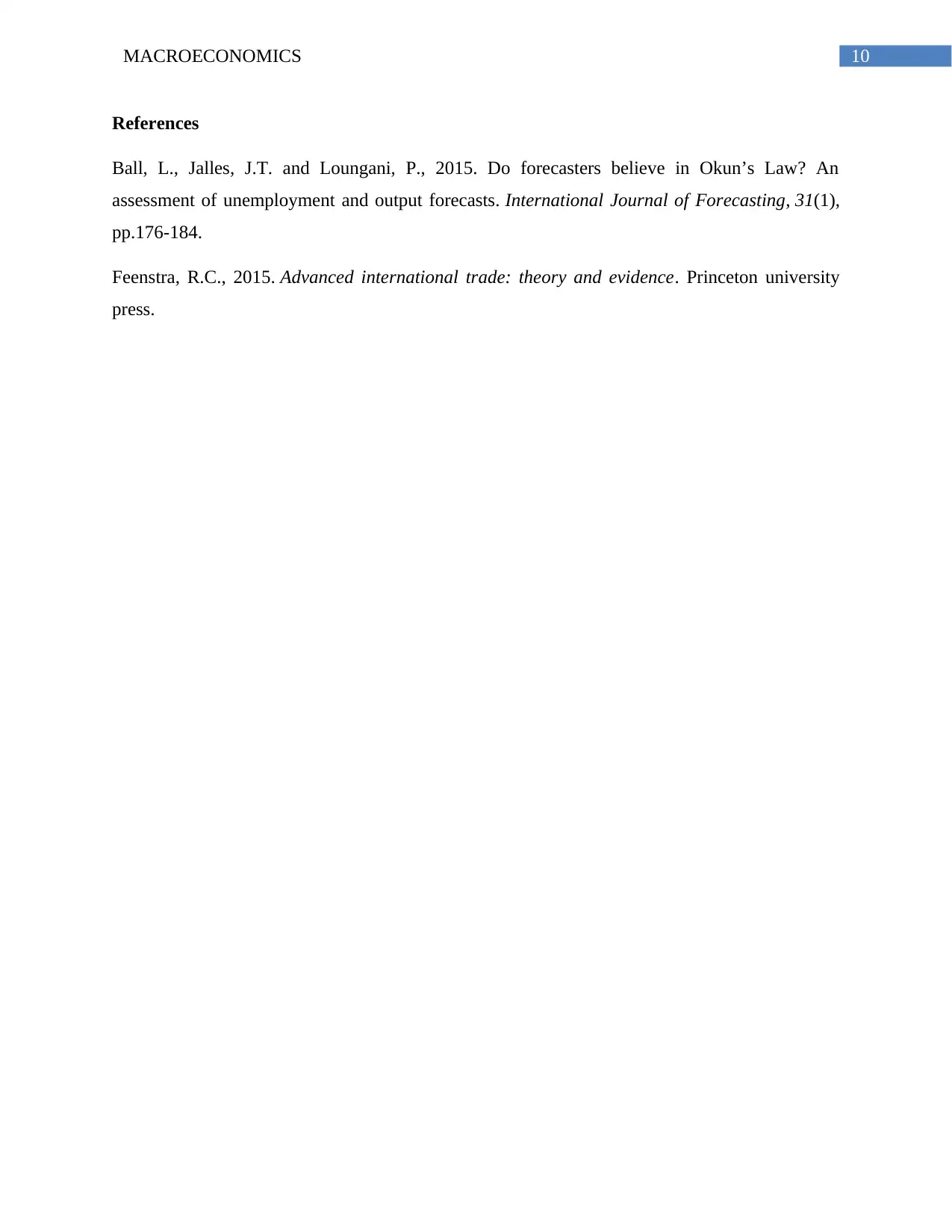
10MACROECONOMICS
References
Ball, L., Jalles, J.T. and Loungani, P., 2015. Do forecasters believe in Okun’s Law? An
assessment of unemployment and output forecasts. International Journal of Forecasting, 31(1),
pp.176-184.
Feenstra, R.C., 2015. Advanced international trade: theory and evidence. Princeton university
press.
References
Ball, L., Jalles, J.T. and Loungani, P., 2015. Do forecasters believe in Okun’s Law? An
assessment of unemployment and output forecasts. International Journal of Forecasting, 31(1),
pp.176-184.
Feenstra, R.C., 2015. Advanced international trade: theory and evidence. Princeton university
press.
1 out of 11
Related Documents
Your All-in-One AI-Powered Toolkit for Academic Success.
+13062052269
info@desklib.com
Available 24*7 on WhatsApp / Email
![[object Object]](/_next/static/media/star-bottom.7253800d.svg)
Unlock your academic potential
Copyright © 2020–2025 A2Z Services. All Rights Reserved. Developed and managed by ZUCOL.




